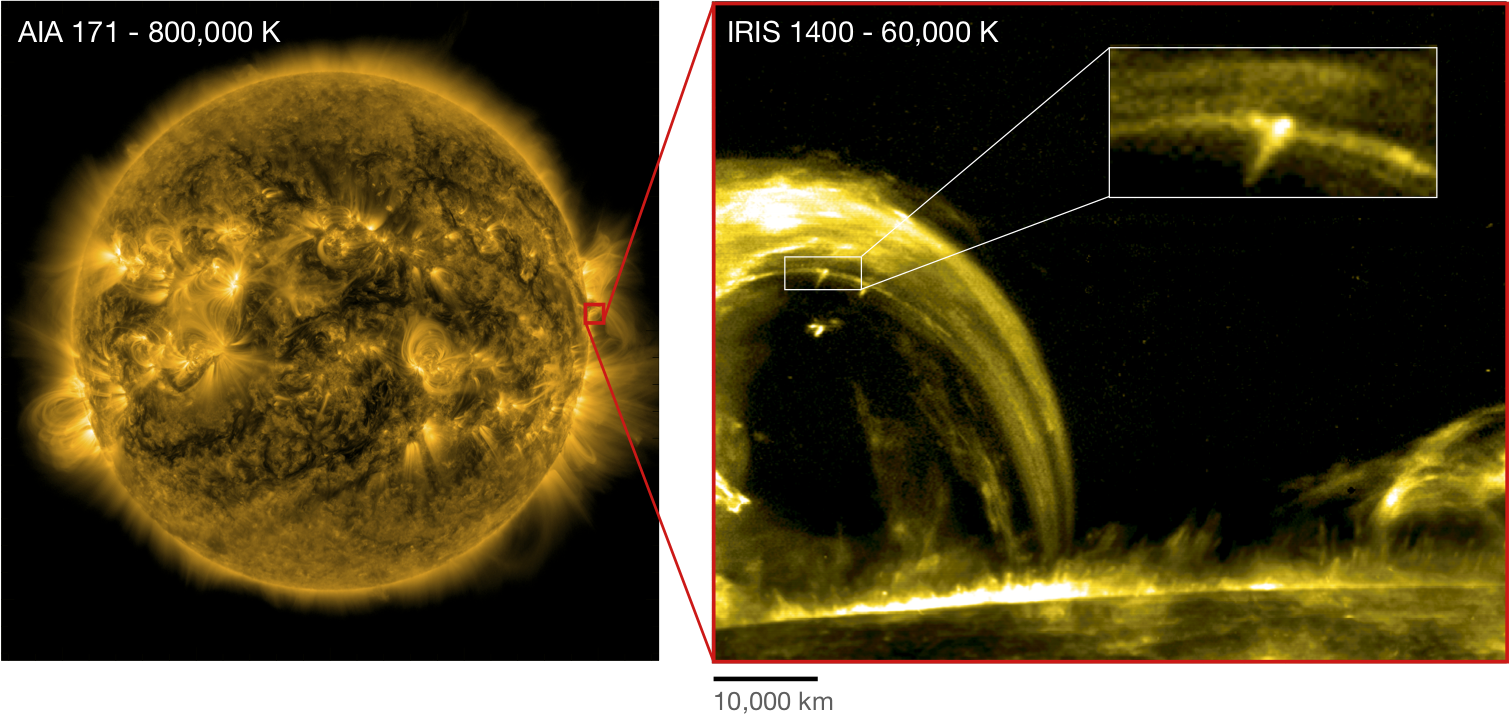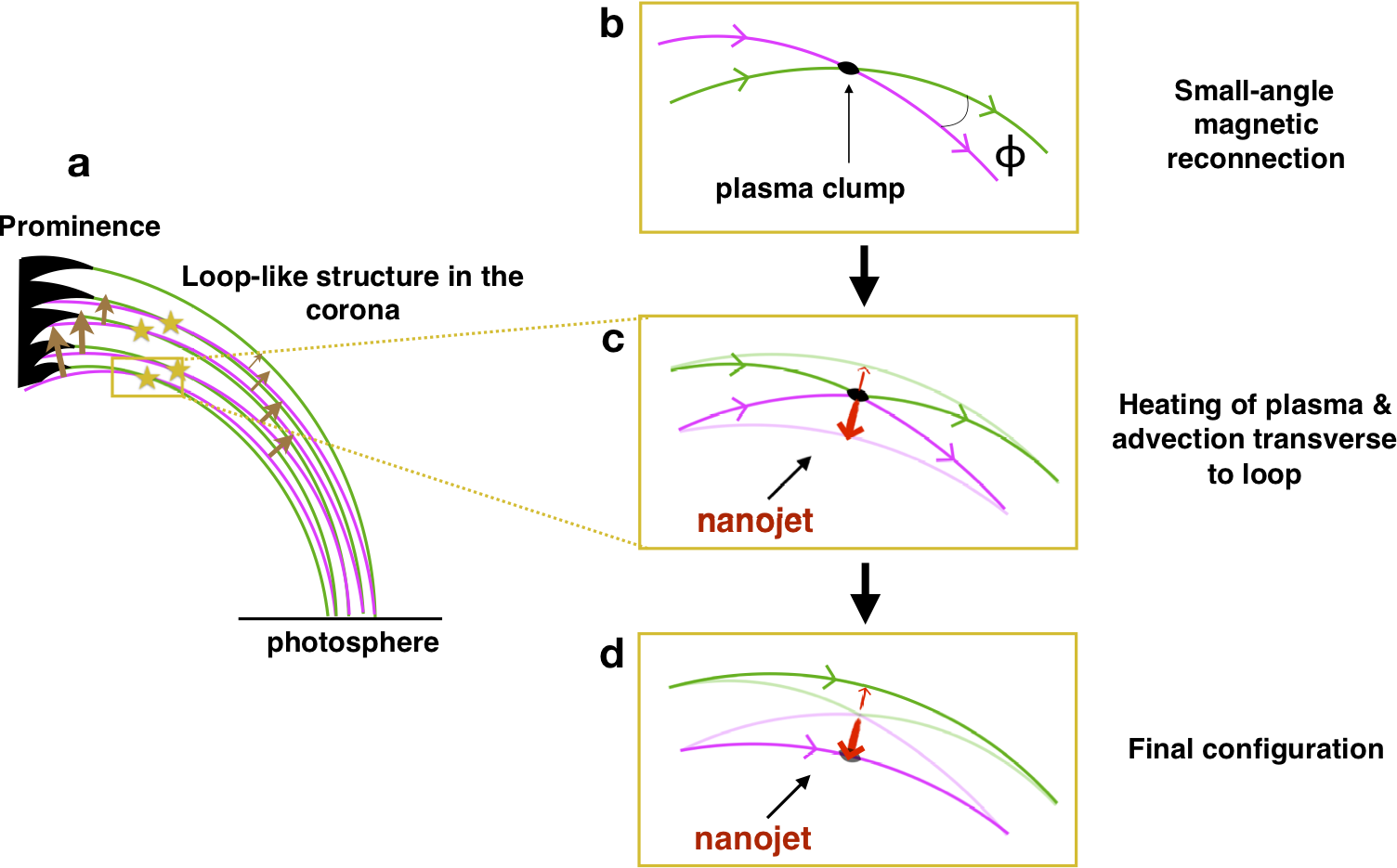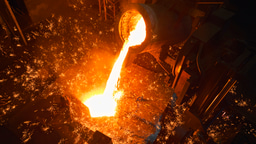Nanojets of Coronal Heating
Published in Astronomy

"The sun beyond the mountain glows, while the Yellow River seawards flows. You can enjoy a great sight by climbing to a greater height" (poet Wang Zhihuan, 8th century),
"Gigantum humeris insidentes" (philosopher Bernard of Chartres, 12th century),
"If I have seen further it is by standing on the shoulders of Giants" (Sir Isaac Newton, 17th century).
-- --
In this work we go to Earth’s orbit heights and stand on the shoulders of both humans and robotic giants to peer into one of the Sun’s most enigmatic phenomena: the solar corona. New observations reveal a long-sought mechanism believed to be responsible for its heating.

The Science behind
The Sun, as with most of the stars in the Universe, is magnetically active, a fact that is reflected by the presence of the solar corona, the outer layer of its atmosphere. The corona is shaped and mysteriously heated to millions of degrees by the magnetic field. Known as the “coronal heating problem”, it is one of the holy grail unsolved problems of astrophysics. The quest for its solution has spear-driven the advance of solar physics for over 80 years.

Wiggly and snappy magnetic ropes
The solar corona is filled with the Sun’s internally generated magnetic field. The field basically takes the shape of loops anchored at the solar surface (the photosphere). The magnetic field lines are therefore constantly perturbed by the bubbly convective motions of the photosphere. Imagine taut and twisted ropes with each opposite end anchored on a different boat during a storm. In a similar way, magnetic field lines become wiggly, stressed, braided with each other, and can even snap. The current major heating theories rely on either the waves that propagate along the field or on the snapping process of the field lines, known as magnetic reconnection. As the name indicates, rather than breaking, the field lines undergo a merging process during reconnection ending in a configuration with lower energy (a less tangled mess).
Parker’s nanoflares
Decades ago, Eugene Parker, one of the solar physics’ giants, hypothesised that the reconnection of magnetic field lines in the solar corona would occur everywhere because of the constant stressing at the footpoints. There is a limit to how much energy the magnetic field lines can carry and how much the magnetic loops can become braided. Parker realised that highly localised reconnection processes would occur, releasing tiny amounts of energy too small to be observed with instruments at that time. Such events were termed “nanoflares” because the amount released in each is expected to be roughly 9 orders of magnitude lower than the famous solar flares. As seen in nature with systems in critical equilibrium, nanoflares would occur in avalanche-like processes, thereby collectively releasing enough energy to heat the magnetic loops to millions of degrees. In the process, the amount of braiding within the loops would be reduced and the system would need to “charge-up” again for the next major heating event.

Nanoflares everywhere?
With the advent of high resolution instrumentation tiny releases of energy on the order of a nanoflare have become detectable nowadays and many reports of such events exist. Does this mean that the corona is being heated by nanoflares with magnetic reconnection as the main driver? Unfortunately not. The problem is that we now know that most heating mechanisms are impulsive in nature and, therefore, that tiny outbursts of energy are not a discriminating factor between theories.
The nanojet: the telltale signature of a nanoflare
Imagine that you are taking a long exposure photo at night of a moving light or a star. What effect do you get? A segment of light, with a longer length for longer exposures or faster motion. Now imagine a bow with a light attached to the string and that after pulling back the string, you release it. In the context of the solar corona, the tensed string of the bow represents the magnetic field, and the bounce-back of the string represents the reconnection process. The field lines detangle due to reconnection and magnetic tension drives the reconnected field lines to a new equilibrium position. Since there is heating where the lines reconnect, the fastest moving part of the field line is the hottest, thereby leading to streaks of light: the “nanojets”. This is exactly what was discovered in this study with high resolution observations with IRIS, SDO and Hinode (all orbiting the Earth and constantly observing the Sun). As shown in Figure 1, and as in the bow comparison, the nanojets appear perpendicular to the direction of the magnetic field (the loop structure), being bright (with an energy in the nanoflare range), extremely short lived (order of 10 s), very fast (on the order of 100 km/s), with lengths of 1,500 km and widths of 500 km (see Figure 2 for a sketch of the process).
Furthermore, a whole bunch of nanojets were observed in an avalanche-like progression, leading to the formation of a hot coronal loop with millions of degrees (Figure 2). Both, clusters of nanojets occurring in very close proximity to each other, and also isolated events (as the one in Figure 1) were observed.
The way forward
What we learned from this study is that nanojets clearly identify nanoflares. That is, they are the signature to look for when magnetic reconnection is the dominant heating mechanism of a coronal loop. Now that we have this telltale signature, we then need to gather statistics about these events and see if they are indeed ubiquitous as Parker originally suggested. If so, then we would have solved the coronal heating problem. However, it is difficult to gather enough statistics at this stage. The fact is, the particular observation from this study corresponds to a very serendipitous observation in which many factors aligned (instrumental, geometrical, etc) to allow the clear observation of this phenomenon. We need the next generation instrumentation to allow us to easily detect such events, as well as the full energetic range of them.
Behind the paper
The challenges behind this paper were enormous and constituted a significant chunk of my research life. It is worth mentioning first that I discovered this particular observation back in 2014, while being a postdoc in Japan (at NAOJ in Tokyo). IRIS being fairly new at the time, there was a huge hype in the air on what sort of results it would bring. I used to browse the recent IRIS observations every week, “straight from the oven” (the oven being the LMSAL website, the main repository for IRIS) and I would be constantly amazed at the new data. The potential of this particular observation struck me instantly. The small “needles” were clear, but I had no idea of what they were at the time. Being involved in various projects and having no time for yet another project then, I hoped that some student would work on it. Instead it gathered dust until I took another postdoc position in St Andrews (UK). My new boss agreed that I should work on it and therefore I immersed myself in it, starting a long 4-year process that ended in Northumbria University and would culminate in the publication in Nature Astronomy, but not before facing major challenges on both the research and the human side.
One of the most difficult tasks for any researcher is to first convince oneself that one’s interpretation is correct, and then a whole new level of difficulty is to convince its peers. Indeed, being a physicist is about developing an instinct for the mechanisms operating behind what we observe. The greater the instinct the more the comprehension. But comprehension does not directly translate into mathematics and equations. Also, even if we think we understand, explaining to somebody else really tests our comprehension.
For this study I instinctively knew there was something big behind the phenomenon but it took a lot of time, discussion with colleagues and perseverance to really grasp what was going on. One of the problems was that the subject of nanoflares in solar physics is a bit “taboo”. Because of its strong link to coronal heating and therefore a high prestige, many works exist claiming their detection without really proving that magnetic reconnection is their driver (and therefore that they are really nanoflares), particularly for coronal observations. Hence, at the beginning of this study there was an effort not to mention nanoflares for the fear of being biased and not seeing a more likely and simpler possibility to explain the phenomenon. However, as work progressed, the elephant in the room could not be ignored anymore. It became clear that what we were observing were nanoflares. The numerical model also took a lot of time, but the combined perseverance with my colleagues clearly paid off, since it provided support for the interpretation.
My suggestion as a researcher is therefore to trust your instinct but also be open to other possibilities. In the end, this is the path of science and physics. We can never really know 100% that a given interpretation is correct, particularly in the realm of astrophysics in which the phenomena occur so far away from Earth. It is always possible that in the future better instrumentation may prove wrong what today we believe to be true.
Another suggestion for young scientists: in the path of science you will always encounter skeptic people that no matter what you say or do you will never be able to convince them. Just ignore them!
Follow the Topic
-
Nature Astronomy

This journal welcomes research across astronomy, astrophysics and planetary science, with the aim of fostering closer interaction between the researchers in each of these areas.
Related Collections
With Collections, you can get published faster and increase your visibility.
Progress towards the Sustainable Development Goals
Publishing Model: Hybrid
Deadline: Ongoing





Please sign in or register for FREE
If you are a registered user on Research Communities by Springer Nature, please sign in